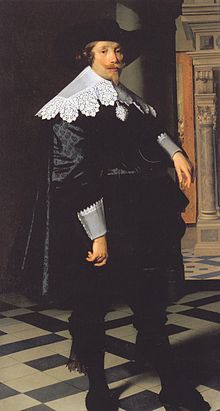| Cornelis de Graeff van Polsbroek | |
|---|---|
 Portrait by Nicolaes Eliaszoon Pickenoy, (1636), Gemäldegalerie, Berlin | |
| Regent and Mayor of Amsterdam | |
| Reign | 1643–1664 |
| Predecessor | Andries Bicker |
| Successor | Andries de Graeff |
| President of the Dutch East Indies Company | |
| Reign | 1646–1664 |
| Predecessor | Andries Bicker |
| Successor | Pieter de Graeff |
| Born | 15 October 1599 House De Keyser, Amsterdam |
| Died | 30 January 1664 (aged 64) |
| Burial | Oude Kerk, Amsterdam |
| Spouse | 1) Geertruid Overlander van Purmerland 2) Catharina Hooft |
| Issue | Pieter de Graeff Jacob de Graeff Other relations Andries de Graeff (brother) Andries Bicker (cousin) Jan de Witt (nephew) Frans Banninck Cocq (brother in law via Catharina) Pieter Corneliszoon Hooft (uncle) |
| House | De Graeff |
| Father | Jacob Dircksz de Graeff |
| Mother | Aeltje Boelens Loen |

Cornelis de Graeff (15 October 1599 – 4 May 1664), often named Polsbroek or de heer van (lord) Polsbroek during his lifetime, was an influential regent and burgomaster (mayor) of Amsterdam, statesman and diplomat of Holland and the Republic of the United Netherlands at the height of the Dutch Golden Age.
He was most illustrious member of the De Graeff family, which in the Golden Age originally held political power together with the Bicker family and by marriage in Amsterdam Holland and finally the Dutch Republic.[1] De Graeff belonged to the republican political movement also referred to as the ‘state oriented’, the Dutch States Party, as opposed to the Orangisten and opponent of the political ambitions of the House of Orange.[2] He was one of the leading figures who sought to end the Eighty Years' War between the United Netherlands and the Kingdom of Spain, which took place in 1648 with the Peace of Münster.[3][4][5] Inside Amsterdam De Graeff became the moderate successor to his ultra-republican cousin Andries Bicker. In the following era after the sudden death of stadholder William II of Orange, the First Stadtholderless Period, which was promoted by De Graeff,[6] he and his nephew Grand pensionary Johan de Witt were regarded as the leading republican protagonists.[7] The progressive cooperation between De Graeff and his protégé De Witt[6] was an important political axis that ordered the political system within the republic.[8] Both belonged now to the two republican and state-minded families where political power within Holland rested primarily with. In Amsterdam this lay with the brothers Cornelis and Andries de Graeff, and in The Hague with the brothers Cornelis and Johan de Witt.[9] Until his death in 1664, De Graeff was Amsterdam's leading politician, then the republican center of the republic. However, he not only had the interests of these in mind, but also those of Holland and the political settlement with the other provinces.[10]
Cornelis de Graeff was considered a prudent and skilful statesman and diplomat who was concerned about the balance between the religious and political factions and was held in high esteem by the population.[11] His political stance was characteristic of his family: on the one hand libertine and state-minded, on the other hand, if only to a limited extent, loyal to the House of Orange. The proponents of the De Graeff family has shown they had an eye for national politics and tried to find some balance between the House of Orange and the Republicans. They were against too much influence of the church on political issues. After his death, his younger brother Andries de Graeff continued the De Graeff faction and its republican and more liberal politics.[11]
Cornelis de Graeff was Free Lord of Zuidpolsbroek, Ambachtsheer (Lord of the Manor) of Sloten, Sloterdijk, Nieuwer-Amstel, Osdorp and Amstelveen and acted as President of the Dutch East Indies Company.[12]
Like his brother, Andries De Graeff, he was an art collector and patron of the arts.
- ^ Biography Andries Bicker at DBNL
- ^ Jephta Dullaart: Triumph of Peace
- ^ Oliver Krause: Die Variabilität frühneuzeitlicher Staatlichkeit. Die niederländische „Staats“-Formierung der Statthaltosen Epoche (1650–1672) als interkontinentales Regiment (Franz Steiner Verlag, Stuttgart 2018)
- ^ Amsterdam: a brief life of the city. By Geert Mak, Harvill Press (1999), p 123
- ^ Buitenplaatsen in de Gouden Eeuw: De rijkdom van het buitenleven in de Republik. By Y. Kuiper, Ben Olde Meierink, Elyze Storms-Smeets, p 71 (2015)
- ^ a b The World, by Simon Sebag Montefiore (2022)
- ^ Life/Death Rhythms of Capitalist Regimes – Debt before Dishonour, p 98, by Will Slatyer (2014)
- ^ DeWitt" — an annotation to Thomas Carlyle's "Signs of the Times" Rachel Klotz '13, English 0600J, Brown University, 2010
- ^ Die vielen Leben des Jan Six: Geschichte einer Amsterdamer Dynastie, by Geert Mak (2016)
- ^ Brugmans, H. (1973) Geschiedenis van Amsterdam. Deel III Bloeitijd, 1621-1697, p 159–167
- ^ a b Pieter C. Vis: Andries de Graeff (1611–1678) ’t Gezagh is heerelyk: doch vol bekommeringen
- ^ Biography Cornelis de Graeff at Nieuw Nederlandsch biografisch woordenboek. Deel 2